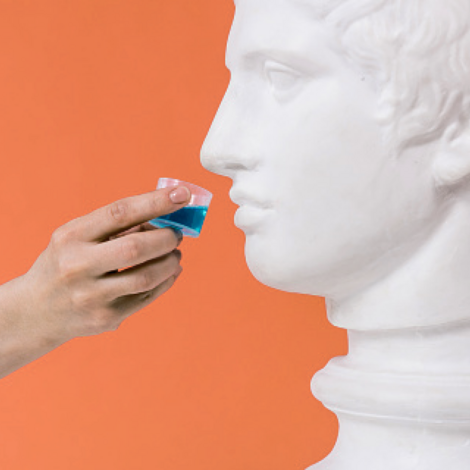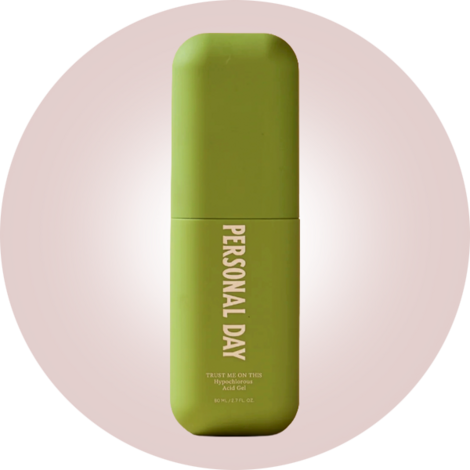I didn’t buy my first bottle of CK One—I earned it using nothing but my devout Catholicism. In second grade, preparing to confess our sins to God for the first time, my Sunday-school class was challenged to learn and recite the prayer that is offered to the priest administering confession: the Act of Contrition. If you recited it correctly before the class, our Sunday-school teachers offered one treasure from their chest of prizes. If your Sunday-school teacher was also your next-door neighbor, who drove you and your siblings to and from the church annex, you got to pick from the rejects stored in the trunk of their car.
My hand hovered over Happy Meal–toy discards and decks of souvenir cards until it closed on a frosted flask of something. It was clearly the most valuable thing in the garbage trunk, and I reasoned that, if my family were to fall on hard times, it would be prudent to pick something I could pawn for grocery money. So CK One was the first fragrance I ever owned. I stashed it in my underwear drawer. As soon as I had learned to ask for God’s absolution, I had discovered Calvin Klein.
CK One was launched in 1994. Its spirit appealed to Gen X, but its true age is that of a millennial, on the cusp of turning 30. Prior to its debut, Calvin Klein’s fragrance portfolio comprised a short list of words that could be hornily whispered in TV ads, evoking sex and possibly imprisonment: Eternity, Obsession, Escape. CK One represented a shift, marketing itself as a unisex fragrance for a generation yet undefined. Contemporaneous launches showed a certain vogue for lightweight, less gendered fragrances—Issey Miyake’s L’Eau d’Issey, Gap Grass, and Comme des Garçons’s first, eponymous scent were also born in 1994—but none was as successful as CK One, which used the occasion of its own launch to cleave the history of fragrance in two: Pre- and Post-One.
Obsession’s television spots were arty and directed by Richard Avedon, but CK One’s were raw and shot by Steven Meisel. In black and white, a posse of androgynes made out or argued or danced or looked to the camera and whispered, “CK One.” The camera passed a 20-year-old Kate Moss, who had just had her big break two years earlier in another Calvin Klein campaign, with Mark Wahlberg. She didn’t whisper: “The only one. CK One. A new fragrance for a man or a woman.”
As soon as I had learned to ask for God’s absolution, I had discovered Calvin Klein.
At the time, Calvin Klein had a monopoly on racy, monochromatic underwear advertisements, which seemed to lend their DNA to CK One. Most of the models wore jeans and tank tops, if they wore shirts at all. Sex sold well for Calvin Klein. The year before CK One launched, the brand’s underwear business was generating about $85 million in yearly revenue. But the stripped-down creative also reflected the fragrance itself, which fit its wearer like a pair of white cotton briefs: clean, understated, invisible, intimate. Some fragrances are designed to unfurl in burlesque revelations. CK One’s composition lays citrus slices across a bed of flowers, spiced by musk and vanilla; on skin, it smells simple, sweet, and soapy.

A team of noses, Alberto Morillas and Harry Frémont, from the century-old fragrance producer Firmenich, helped take CK One from brief to bottle. Morillas had spent more than two decades mixing fragrances for European houses before CK One drew his attention from across the Atlantic. “CK One didn’t smell like America at all,” he says. “It was a time when big, bold fragrances were very popular, and CK One is very different—fresh with floral, icy notes and a little vanilla. It transforms and smells different on each skin.” As he told Fragrantica, “It can be appropriated.”
But was it really the future fragrance as prophesied? When it launched, 20 bottles of CK One were sold every minute, according to the company. By the mid-1990s, the fragrance appeared to be outselling undies. And to Morillas’s point, it was appropriated, many times over, including, but not limited to: CK Be (1996), CK One Summer (2004), CK One Electric (2006), and please trust me that I could go on. In 2020, the brand launched CK Everyone, which amended One’s mission statement for a less binary generation. Morillas reprised the formula, now marketed as clean, vegan, and “gender-free”—not simply “for a man or a woman.”
“CK One didn’t smell like America at all.”
Calvin Klein’s sex-forward advertising drew the ire of the Christian right. Around the time of CK One, a reverend in Mississippi implored the Justice Department to investigate the brand for child pornography, and Charles W. Colson, a Nixon lawyer who served time after Watergate, decried the ads in a polemic for the Religion News Service. They would be delighted to know that I reached the age of consent before CK One inspired me to do something unchaste. I smelled like bergamot on musk when a boy pressed me up against his car and kissed me. It was raining; it was perfect. Forgive me, Father, for I have sinned! Between then and the moment I was assigned to write this, I had sworn off the stuff. An act of contrition, maybe. But now, unspoiled by other scent memories, whenever I spray on CK One, the first thing I smell is the rain.
Brennan Kilbane is a New York–based writer. He is originally from Cleveland, and his interviews and essays have appeared in GQ, New York, and Allure, where he was recently on staff as a features writer





